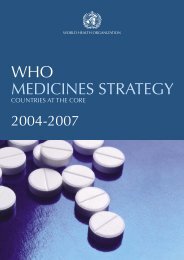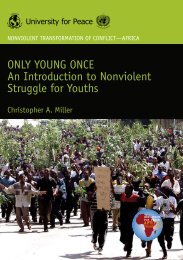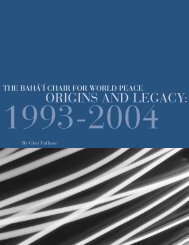environmental degradation as a cause of conflict in - Steiner Graphics
environmental degradation as a cause of conflict in - Steiner Graphics
environmental degradation as a cause of conflict in - Steiner Graphics
Create successful ePaper yourself
Turn your PDF publications into a flip-book with our unique Google optimized e-Paper software.
IntroductionTHE residents <strong>of</strong> the Umm Kaddada area <strong>in</strong> E<strong>as</strong>tern Darfur, like most others atcomparable latitudes with<strong>in</strong> the Sudanese-Sahelian Belt, previously practiseda form <strong>of</strong> farm<strong>in</strong>g which enabled them to restore soil fertility. Now they aresuffer<strong>in</strong>g from a self-perpetuat<strong>in</strong>g cycle <strong>of</strong> drought, deforestation, shortened fallowperiod, less soil fertility and decl<strong>in</strong><strong>in</strong>g crop yields. Their future wellbe<strong>in</strong>g dependslargely on break<strong>in</strong>g this cycle.Before the current destructive cycle began, farmers grew millet, sorghum,groundnuts, sesame and watermelon, all adjusted <strong>in</strong> a rotation <strong>of</strong> 3-10 years whichalso allowed for the practice <strong>of</strong> gum Arabic production. This practice allowed thefarmers to earn a c<strong>as</strong>h <strong>in</strong>come by sell<strong>in</strong>g the gum Arabic for export, while simultaneouslybenefit<strong>in</strong>g from the nitrogen-fix<strong>in</strong>g and soil-reta<strong>in</strong><strong>in</strong>g properties <strong>of</strong> thetrees, which restored the fertility <strong>of</strong> the soil. The advent <strong>of</strong> drought conditions <strong>in</strong>the area, aided by population growth, <strong>in</strong>cre<strong>as</strong>ed local demand for fuel and pressurefor greater food production, which h<strong>as</strong> led to decre<strong>as</strong>ed periods <strong>of</strong> fallow and henceto the removal <strong>of</strong> the vegetation cover and the <strong>degradation</strong> <strong>of</strong> the top soil layer onthe qoz sands. The ultimate result <strong>of</strong> this process is the reactivation <strong>of</strong> the consolidatedsand dunes and the enhancement <strong>of</strong> the mov<strong>in</strong>g sands with all its ecologicaland socioeconomic consequences.Decre<strong>as</strong><strong>in</strong>g <strong>in</strong>come h<strong>as</strong> forced the local population to resort to other alternativeswhich <strong>in</strong> turn had speeded up the process <strong>of</strong> <strong>degradation</strong>. At the same timethe prevalence <strong>of</strong> drought conditions <strong>in</strong> the northern parts <strong>of</strong> Darfur and Kord<strong>of</strong>anh<strong>as</strong> pushed <strong>in</strong>to the area under study p<strong>as</strong>toralists <strong>in</strong> huge numbers, search<strong>in</strong>g forp<strong>as</strong>ture and water, thus <strong>in</strong>tensify<strong>in</strong>g the ongo<strong>in</strong>g process <strong>of</strong> desertification.These chang<strong>in</strong>g circumstances, however, have received for a long time no correctiveat all. The remoteness <strong>of</strong> the area and its harsh <strong>environmental</strong> conditionsh<strong>as</strong> sheltered it from any attempts to me<strong>as</strong>ure the scope and magnitude <strong>of</strong> thedeterioration. The sporadic attempts to counteract desertification and deforestationmade <strong>in</strong> other parts <strong>of</strong> the country s<strong>in</strong>ce the early forties have not affectedthis area. Even the M<strong>as</strong>ter Plan to combat desertification <strong>in</strong> the Sudan which w<strong>as</strong>prepared jo<strong>in</strong>tly by the M<strong>in</strong>istry <strong>of</strong> Agriculture, the US National Research Council,the United Nations Environment and Development Program, and the Food and AgricultureOrganisation (FAO) did not <strong>in</strong>clude this area. The result<strong>in</strong>g Desert EncroachmentControl and Rehabilitation Program (DECARP) did not operate <strong>in</strong> this area,despite its substantial contribution to the gum Arabic production. None <strong>of</strong> its threesub-projects, sand dune fixation, shelterbelt, and gum belt restock<strong>in</strong>g, h<strong>as</strong> beenimplemented <strong>in</strong> this area.The present paper is concerned with some <strong>as</strong>pects related to the physical andnon-physical environment <strong>of</strong> the Umm Kaddada area <strong>in</strong> E<strong>as</strong>tern Darfur. The work46











